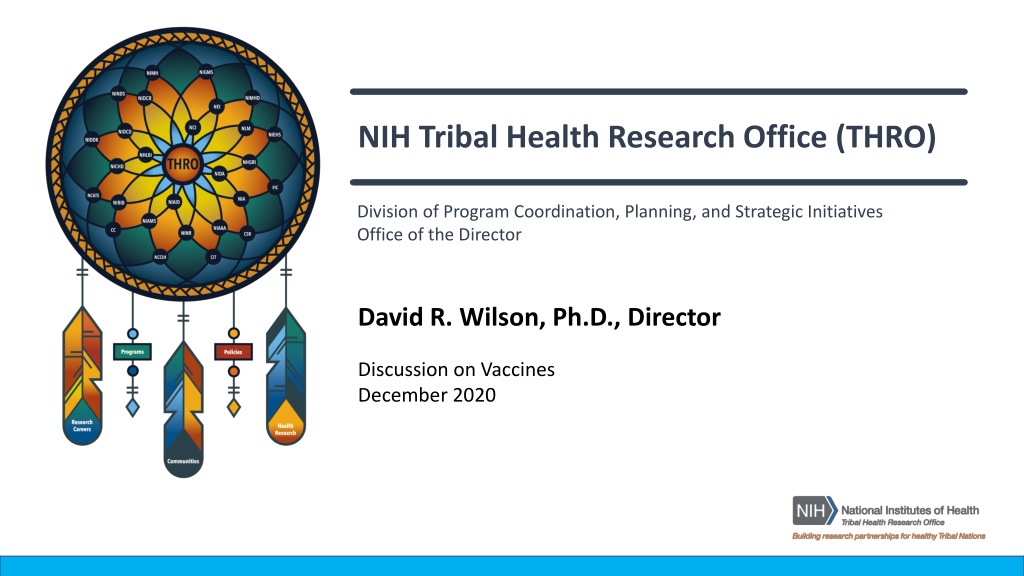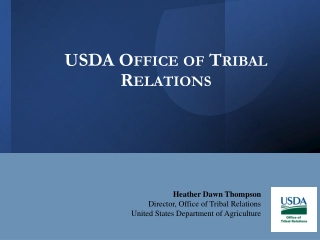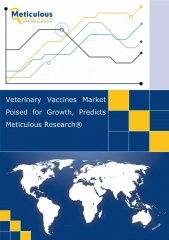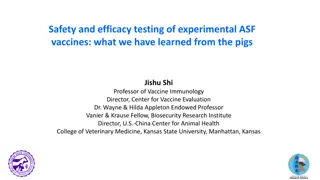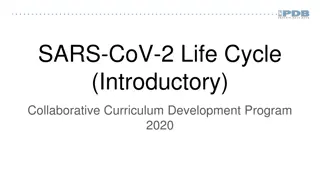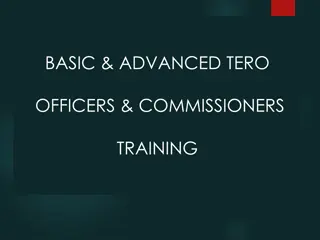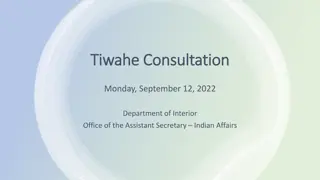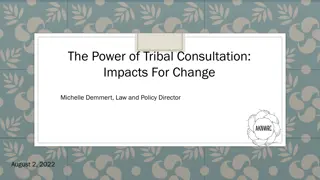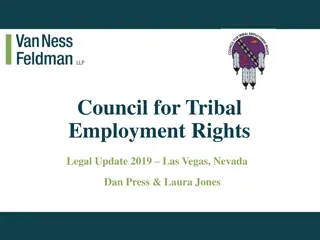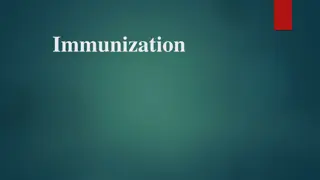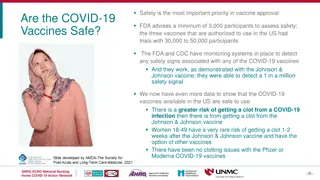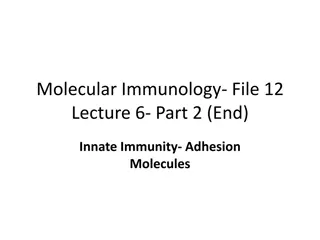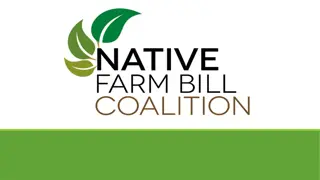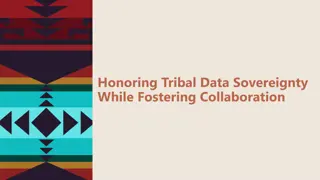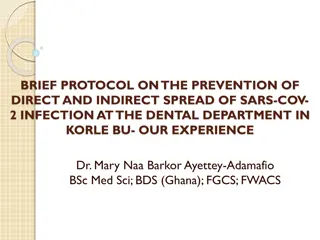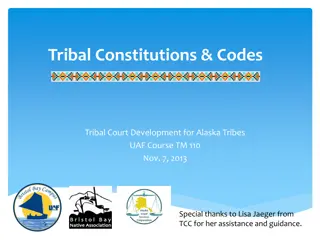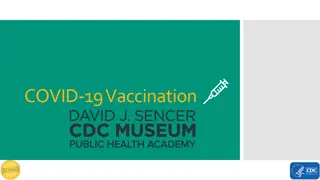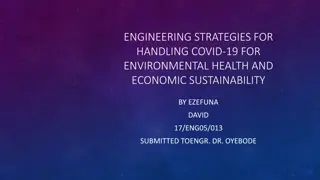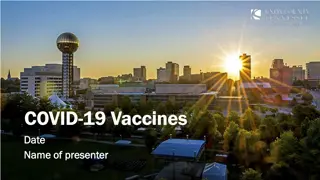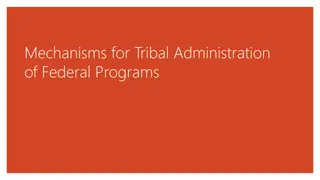Understanding the Impact and Hope for SARS-CoV-2 Vaccines in Tribal Communities
Explore the historical burden of pandemics on American Indian and Alaska Native populations, highlighting the challenges faced during past influenza outbreaks and the current SARS-CoV-2 pandemic. Learn about the importance and hope associated with SARS-CoV-2 vaccines in benefiting both the community and individuals, reducing transmission, building healthier communities, and preventing severe illness. Discover how vaccines teach the body to recognize and combat invaders like SARS-CoV-2, ultimately aiming to block or control the virus. Additionally, delve into the role of antibodies in blocking the spike protein of the coronavirus from infecting human cells.
Download Presentation

Please find below an Image/Link to download the presentation.
The content on the website is provided AS IS for your information and personal use only. It may not be sold, licensed, or shared on other websites without obtaining consent from the author. Download presentation by click this link. If you encounter any issues during the download, it is possible that the publisher has removed the file from their server.
E N D
Presentation Transcript
NIH Tribal Health Research Office (THRO) Division of Program Coordination, Planning, and Strategic Initiatives Office of the Director David R. Wilson, Ph.D., Director Discussion on Vaccines December 2020
History of pandemics in tribal communities Historically, pandemics have had significant burden on American Indian and Alaska Native populations. 1918 Influenza pandemic: Mortality rates among AI populations were 4 times higher than rates in larger U.S. cities. Across the U.S. and other countries, there was increased mortality rates in Indigenous populations, compared to other populations. 2009 H1N1 pandemic: In 12 U.S. states, mortality rates were 4 times higher in Native populations than other populations. American Indians in the Southwest U.S. had higher hospitalization rates than other populations in the U.S. Diabetes among adults and asthma among children were independent risk factors for hospitalization with H1N1.
SARS-CoV-2 SARS-CoV-2 is the name of the new coronavirus discovered in late 2019. It is the virus that causes the disease called COVID-19, short for Coronavirus Disease of 2019. In most people, the virus mainly affects the respiratory tract, but we are still learning about all the ways it impacts the human body. People can carry this virus and transmit it to others, even when they do not have symptoms themselves. Some people do not show any symptoms ( asymptomatic ). Some people have a mild to moderate infection and can recover at home. Others may have a more severe illness and need to be treated in the hospital. Credit: Seattle & King County Dept. of Public Health
What is the hope for a SARS-CoV-2 vaccine? Benefit the community Benefit the individual Reduce transmission Healthier communities Reduce the severity of illness Prevent infection
What is the hope for a SARS-CoV-2 vaccine? Teach the body to recognize and fight invaders Body recognizes SARS-CoV-2 Body GOAL: SARS-CoV-2 is blocked or controlled Fighter cells and proteins go into action sounds alarm
Coronavirus contacting human cells The coronavirus spike protein attaches to the ACE2 receptor to start an infection. Credit: Vaccine Research Center, NIAID, NIH Cells in human body Coronavirus
The goal: antibodies! Vaccine-induced antibodies can block the spike protein from attaching to human cells. Antibodies Credit: Vaccine Research Center, NIAID, NIH Cells in human body Coronavirus
Can vaccines cause SARS-CoV-2 infection or cause COVID-19? NO! The vaccines being tested are made from synthetic (laboratory-made) pieces copied from SARS-CoV-2, not the whole virus. Therefore, the vaccines CANNOT cause infection or cause you to get COVID-19.
How do you test a vaccine? IDEAS LAB RESEARCH ANIMAL TESTING HUMAN STUDIES
Stages of clinical trials Traditional stages: PHASE 1 PHASE 2 PHASE 3 12 to 18 months Test safety and whether the body can tolerate the product Often involves comparing against a placebo with no active ingredients Usually <100 people Up to 2 years Identify the maximum tolerated dose, the best dosing schedule Assess the immune responses Usually a few hundred to a few thousand people 2+ years Efficacy: Does this product prevent infections, or help to reduce the severity of disease? Involves thousands of people, including some at risk of infection With SARS-CoV-2, no phases are skipped. Instead, we overlap the phases, starting the next phase as the necessary safety data are collected and analyzed from the earlier phase. The new phase can start while the long-term follow-up of people in the earlier phase continues. Other steps can be done in parallel, instead of one after the other. PHASE 1 SARS-CoV-2: Efficient stages PHASE 2 PHASE 3 PHASE 4 10
COVID-19 vaccines in late phase clinical trials in the U.S. Planned Start July Specimens Collected Blood, nasal swab Planned Follow-up 2 years Developer Platform Eligibility Number of Doses Moderna mRNA 18+ years, healthy or medically stable, no prior COVID-19 18-85 years, healthy or medically stable, no prior COVID-19 18+ years, healthy or medically stable 2 doses, 28 days apart Pfizer/ BioNTech mRNA August 2 doses, 21 days apart Blood, nasal swab 2 years Oxford/Astra- Zeneca August 2 doses, 28 days apart Blood, nasal swab, saliva 2 years Adenovirus vector Janssen September Healthy 18-59 years first, then add in 60+ years, with and without comorbidities 18+ years, healthy or medically stable 1 or 2 doses, 8 weeks apart Blood, nasal swab, saliva 1 year and 3 months Adenovirus vector Novavax October 2 doses, 21 days apart Blood, nasal swab 2 years Protein nanoparticle Sanofi/GSK Protein Subunit
Moderna/mRNA-1273: The COVE Study mRNA platform Translated in the cytosol to the coronavirus spike protein mRNA vaccines are not made with pathogen particles so are non-infectious mRNA is degraded after translation; it does not enter the nucleus or become integrated into the host genome RNA vaccines are much quicker and simpler to make Storage at -20C 12
Moderna/mRNA-1273: The COVE Study Phase 1/2 results Vaccine elicits antibody immune responses and cellular immunity Adverse reactions Injection site pain was most common local reaction Fatigue, headache, chills, muscle pain, joint pain, and fever were most common systemic events Increased with dose level Greater after the second dose compared to the first Phase 2/3 currently ongoing: NCT04470427 Will enroll >40,000 people aged 18-85 years from 120 sites globally Over 30,000 enrolled to date (<0.5% Native American) 13
Study timeline: Moderna/mRNA-1273 The COVE Study Visit 3 1-Month Follow-up Visit 2 Day 28 Visit 1 Day 1 Visit 5 12-Month Follow-up Visit 4 6-Month Follow-up Visit 6 24-Month Follow-up Receive injection Blood sample Nasal swab Physical exam Medical history 14
Astra Zeneca / AZD1222 Phase 1/2 results: Vaccine elicits antibody immune responses and cellular immunity Adverse reactions: fever, fatigue, and chills Phase 2/3 currently ongoing: The vaccine is now being tested by more than 75 clinical sites in the U.S. Approximately 30,000 participants from the U.S. will participate. Participants will be randomized in a 2:1 ratio to receive either a dose of AZD1222 vaccine or placebo. ChAdOx1 platform (Adenovirus Vector) non replicating Produces coronavirus spike protein Development of the vaccine was initiated by the University of Oxford in the United Kingdom Antibodies generated to bind spike protein Spike protein ChAdOx1 15
Study timeline: Astra Zeneca Visit 3 1-Month Follow-up Visit 2 Day 29 Visit 1 Day 1 Visit 5 12-Month Follow-up Visit 4 6-Month Follow-up Visit 6 24-Month Follow-up Receive injection Blood sample Nasal swab Physical exam Medical history 16
Novavax 2019nCoV-301 Vaccine uses antigen derived from the coronavirus spike protein to stimulate neutralizing antibodies Protein platform: Use part of coronavirus protein with Matrix-M1 to provoke an immune response coronavirus spike protein Antibodies produced to bind spike protein Phase 1/2 results: (Tested on 131 people aged 18-59) Vaccine elicits antibody immune responses and cellular immunity Some adverse reactions (fever, fatigue, and chills) Phase 2 ongoing Phase 3: Will enroll ~30,000 people aged 18 years from sites globally; enrollment slated to begin in October. 17
Data and Safety Monitoring Board (DSMB) A committee of clinical research experts, such as physicians and statisticians, and patient advocates who monitor the progress of a clinical trial and review safety and effectiveness data while the trial is ongoing. This committee is independent of the people, organizations, and institutions conducting the clinical trial. Data and Safety Monitoring Boards (DSMBs) can recommend that a trial be stopped early because of concerns about participant safety or because the main research question has been answered. DSMB is monitoring all ongoing clinical trials: vaccines, monoclonal antibodies, antivirals, and immunomodulators. Pauses on clinical trials are very common, especially in phase 3 trials enlisting tens of thousands of participants. Demonstrates participant safety is a priority. 19
Alaska Portland Great Plains * Tribes in IHS Areas that are participating in Clinical Trials or received Technical Assistance related to Clinical Trials Phoenix Nashville Navajo Tucson 20
Connect with us and learn more David R. Wilson, Ph.D., Director dave.wilson2@nih.gov Juliana Blome, Ph.D., Deputy Director juliana.blome@nih.gov Website https://www.nih.gov/tribalhealth Facebook @NIHTribalHealth
